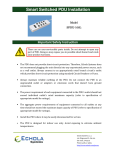Download OS214 User`s manual
Transcript
Quick Installation & Operating Guide
OS214-MM/SM – 5 PORT (1x4 DUPLEX ) OPTICAL switch
Echola Systems L.L.C
1161 Ringwood Ct, Ste 100
San Jose, CA-95131
Phone: 408 321 9663
Fax: 408 321 9663
http://www.echola.com/optical
Installation
OS214 is a Linux based 5 port (1x4 duplex) Layer 1 optical switch used in
patch panel automation applications to share one expensive device with four
other optical devices. It provides a serial (RS232) and an Ethernet (10/100)
port connectivity for management. Serial port is normally used in special
situations such as to debug network connectivity if OS214 is not reachable
through Ethernet.
You might require a Laptop or a PC to configure OS214 with an IP address
before connecting to your network so that you would be able to access
OS214 from remote. You could either use Serial or Ethernet port to
configure IP. If you use serial port using supplied null modem cable then
you would need to configure serial for 38400 baud rate with 8-N-1 to access
OS214. If your PC doesn’t have a serial Port then you need to use a serial to
USB converter, which is not supplied with the product, to connect to PC’s
USB port.
If you use Ethernet then you would need to configure the PC or Laptop’s IP
to match OS214’s default network. The default network configuration is as
follows
IP Address: 10.1.1.100
Mask: 255.255.255.0
Gateway: 10.1.1.1
DNS: 10.1.1.1
If you have successfully configured Serial or Ethernet then you would see
the os214 login prompt; login as “root” to setup network.
root’s password: osctl
There is one non-root default user available on OS214 which can be used
once the switch is setup (for doing switching of port).
username: osctl
password: osctl
2
Configuring Static IP
Use “osctl” command to configure a static IP address after login as “root”
user. “osctl -?” shows detailed osctl command options with examples.
# osctl -i 192.168.1.10 -m 255.255.255.0 -g 192.168.1.1
The above command configures IP address of OS214 as 192.168.1.10 with
mask 255.255.255.0 and gateway & DNS as 192.168.1. Once the IP is
configured from a PC or a Laptop using Ethernet or serial port, you can then
connect OS214 to your network and access it using “telnet” or “ssh”.
Configuring Dynamic IP
If you have a DHCP server running on your network and you want to
dynamically assign an available IP address to OS214 then use following
option.
# osctl -D
Make sure you know the assigned IP address to login using “telnet” or “ssh”
next time.
Configuring Hostname
You can also change the hostname of OS214 switch using “osctl”.
# osctl –h OS214-SW-1
The above command changes hostname of OS214 to OS214-SW-1.
Configuring DNS/Nameserver
To configure a DNS or Nameserver, you can use “-n” option of osctl.
# osctl –n 192.168.1.11
Configuring Syslog Server
To send system generated events to an external syslog server, use “–S”
option of osctl. You have to specify the address of the syslog server which
will receive these event logs. (Note: this option only available in software
3
version 2.0 and above).
# osctl –S 192.168.1.200
Version Info
The following command shows hardware and software versions and serial
number of the switch.
# osctl –v
Other Administrative commands
Most of other administrative functions can be done using standard Linux
commands. For example, to change the password use “passwd” command
from the Linux prompt and to add new user use “useradd” command. You
have to be “root” user in order to add a new user.
4
Operation
OS214’s front panel has 5 ports with LC duplex connectors numbered left to
right IN and 1-4. The input port is labeled as “IN” and 4 output ports
labeled as “O1”, “O2”, “O3” and “O4”. Even though we refer ports as input
and output ports they are bi-directional (duplex) so you can use them as
either input or output. This means switch can act as 1x4 or 4x1 switch.
LEDs to indicate
which output
port the input
port (IN) is
connected to
IN
Input
The input port’s Tx and Rx are
internally connected to
corresponding output ports’ Tx
and Rx. This way you can share
one device with 4 other devices
and switch between.
O1
O2
O3
O4
Output ports
OUTPUT 1
111
OUTPUT 2
INPUT
OUTPUT 3
Duplex 1x4 switch
OUTPUT 4
5
The switching of light from input port to any of the four output ports can be
achieved using a command line interface. To simply the operation, all
functions are provided in a single command called “osctl”. Osctl provides
three major functionalities.
1. Network & Host configuration (allowed only in “root”)
2. Switch Control & Status
3. Port group Management
Osctl will show correct syntax usage if you make mistakes in typing
command options. It will also provide some examples on how to use the
command when you make mistakes. Also you may use “osctl -?” which
shows all syntaxes with all examples.
Network & Host configuration
Network setup has 4 different syntaxes.
1. To configure static IP
# osctl -i <ip> -m <mask> -g <gw>
2. To use DHCP
# osctl -D
3. To configure hostname alone
# osctl -h <hostname>
4. To configure DNS/NameServer
# osctl -n <dns ip addr>
5. To configure Syslog server for event logging
# osctl –S <syslog server ip addr>
For details refer to installation section as these are explained in that section.
6
Switch Control
In order to switch input to output port 1 to 4 you have to use osctl in
following way.
$ osctl -p <1|2|3|4> [-t <secs>]
Note that the “|” is equivalent to “or”. If the options are in square brackets
“[]” then it is optional.
For example:
$ osctl -p 4
switch input port to output port 4. Now port ‘IN’ and port O4 are
connected; the LED on output port 4 lights up when this command
is issued which confirms that the input port is switched to out port 4.
$ osctl -p 1
switch input port to output port 1. Now port ‘IN’ and port ‘O1’ are
connected; the LED on output port 1 lights up when this command
is issued which confirms that the input port is switched to out port 1.
$ osctl -p 2 -t 120
switch/connect input port ‘IN’ to output port 2 after 120 secs
(delayed switching).
7
Switch Status
Following command shows the status of the switch.
$ osctl -s [<port#>]
For example:
$ osctl -s
shows port status as follows. Note that first column shows Port 1
which refers to input port. The second column is the one you should
look at which shows what port is connected to the input port
currently. In this case it is 4th output port.
All Ports Status
==========================
Port
| Port Status
==========================
1
|
4
-----------------------------------------------------------------
$ osctl -s 2
shows port 2 status only
8
Automating OS214 Optical Switch
In order to automate OS214 switch you would need to write tcl/expect based
script. The tcl and expect scripting languages are easy to learn. We have
given an example script at the end which you can modify to suit your need.
There are tons of online sources for learning tcl & expect.
The following provides quick high level overview of tcl and expect
http://cplug.org/t/uploads/2009/02/tcl-expect.pdf. There is a good book from
O’Reilly which provides great insight into expect language itself: “Exploring
Expect: A Tcl-based Toolkit for Automating Interactive Programs (Nutshell
Handbooks)”.
Running scripts from Unix/Linux systems
If you want to run the script from a Unix/Linux based machines then there is
possibility that you may be already having these tools on your system. Check
if it’s already been installed by typing “expect” from Unix/Linux prompt. If it
is not then you will have to install it using package install tool for that
particular flavor of Unix/Linux. For instance, on Fedore core Linux, you can
use “yum install tcl expect” to install tcl and expect.
Running scripts from Windows
For windows based systems you can install windows free community version
of ActiveTcl from Activestate http://www.activestate.com/activetcl/downloads.
The expect is not available yet for 64bit version of Windows 7/Vista. So you
will need to download 32bit version for ActiveTcl first and then make sure to
install “expect” using command “teacup install Expect”.
Also you need to enable “telnet” client on Windows before running any
scripts. In order to enable telnet on Windows follow these steps
•
•
•
•
•
•
Start
Control Panel
Programs And Features
Turn Windows features on or off
Check Telnet Client
Hit OK
After that you can start Telnet via Command Prompt to check if it works.
9
The following sample script actually login into OS214 switch and issue a
switch command then check whether the switch command was successful
and return the result before terminating the telnet session.
This script takes argument (port number and state of the port (on/off)) from
commands line argument. Cut and Paste the following script on to any editor
and save as “rosctl”. Then you can run the script from any machine which
supports tcl/expect by issuing rosctl -p <port#>. For instance, to switch
input port to output port 2, you can call script as rosctl -p 2.
Make sure you have proper path set for expect on first line
“#!/usr/bin/expect” for Unix/Linux based systems. For windows you will
have to uncomment ‘ exec’ and ‘package’ commands as mentioned in the
script. All comments inside ‘#’ provide more info on what the script is doing.
10
The Sample Tcl/Expect script
#!/usr/bin/expect
##############################################################################
# Script switches to given port and verifies if the port is switched from a remote machine
#
Command Usage: rosctl -p <port#>
##############################################################################
# If you run this from a Windows machine, uncomment following
# exec tclsh "$0" ${1+"$@"}
# package require Expect
# Check number of arguments passed to this command if < 3 then spit out error & exit
if { $argc < 2 } {
puts "Usage: rosctl -p <port#> \n"
exit 1
}
# Set telnet host, username, password and other parameters, modify these to reflect your setup
set hostname "192.168.2.20"
set username "osctl"
set password "osctl"
set prompt "osctl@.*\$"
set port [lindex $argv 1]
set commandcontrol "osctl -p $port"
set commandstatus "osctl -s $port"
# Display info.
puts "Connecting to $hostname."
# Connect to the telent server using the "spawn" command.
spawn telnet $hostname
# Wait for a login prompt.
expect -re "(Name|login|Login|Username).*:.*" {
# Login prompt received. Send user name to OS214.
send "$username\r"
} eof {
# No login prompt received. Display an error.
puts "could not connect\n"
}
# Wait for a password prompt from the OS214.
11
expect "Password:" {
# Password prompt received. Send the password.
send "$password\r"
}
# Wait for the switch prompt.
expect -re $prompt {
# Issue osctl command to switch given port
send "$commandcontrol\r"
}
# Wait for the switch prompt again to check status.
expect -re $prompt {
# Issue osctl command to check status
send "$commandstatus\r"
}
# Discard echoed command - we need only the status
expect "$commandstatus\r"
# Discard unwanted prompt as well
expect -re "(.*)$prompt"
#Debug
#puts "\n GOTS ####$expect_out(1,string)#####\n"
# Save remaining to buffer 'data'
set data $expect_out(1,string)
# Check return status and display result accordingly
switch -re $data {
"1" { puts "Input port is now connected to $port" }
"2" { puts "Input port is now connected to $port" }
"3" { puts "Input port is now connected to $port" }
"4" { puts "Input port is now connected to $port" }
default { puts "Input port is now connected to unknown port!" }
}
# Terminate telnet
send "exit\r"
12
Troubleshooting
If you use telnet and is very slow, it could be due to name server /
DNS issue. Make sure you have name server configured correctly (n option). Try “ping <name_server_ip>” to see if name server
configured can be reached from OS214. If you don’t have dns on
your network then you can just remove file “/etc/resolv.conf” and
see if it works normal.
All the group information is stored in a hidden XML database file. If
for some reason this file is corrupted, the system will recover from
this error by trying to copy the backup database file. If this happens
it will throw a warning message but it is not guaranteed that all the
group information will be restored correctly. In that case you may
need to recreate missing groups.
13
Hardware Specifications
Electrical
Input Power
Total Power Consumption
Serial Port
Networking
100-240 AC
< 7 Watts
1x RS232
1x 10/100 Ethernet
Optical
Connectivity
Data rate
Wavelength (nm
nm)
nm
5 Duplex LC ports
No limitation - Physical Layer Switch
Optical Technology
Insertion Loss (dB
dB)
dB
1x4 Electro-mechanical-optical switch
0.5 Typical, 0.8 Max. (without
connectors)
≤ 10
≤ -80
≤ 0.1
OS414-SM
1280-1340 nm
1520-1625 nm
OS414-MM
850/1310 nm
Switching Time (ms
ms)
ms
Crosstalk (dB
dB)
dB
Repeatability (dB
dB)
dB
Mechanical & Environmental
Each Switch’s Durability (Cycles
Cycles)
Cycles
Chassis (RU
RU)
RU
Dimension (inch
inch)
inch
Operating Temperature range (˚C
˚C)
˚C
Storage Temperature range (˚C
˚C)
˚C
Humidity
14
> 10 7
1 RU
19 (W) x 9(D) x 1.75 (H)
-20 ~ 75
-40 ~ 70
5 – 85 % RH
Contact Info
If you have any technical questions and need help you can send email to
[email protected] or call 408-321-9663. You can also download latest
documents and software from our website www.echola.com.
15
































